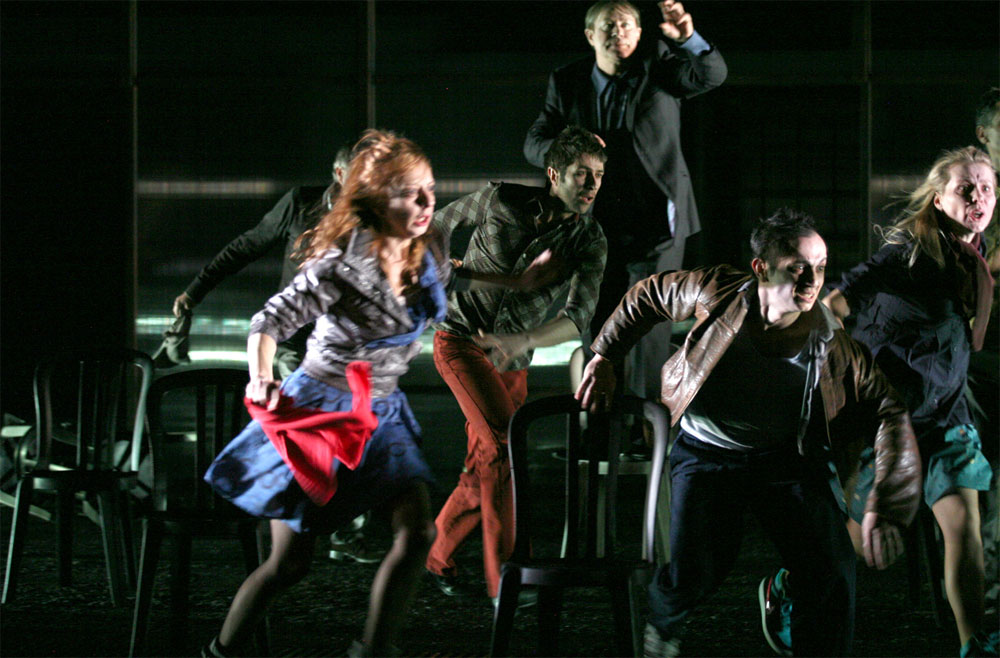Imagine walking down the street, minding your own business, and suddenly witnessing your neighbor transform into a rhinoceros. This bizarre scenario is not a feverish dream but the very premise of Eugène Ionesco’s groundbreaking play “Rhinoceros,” a masterpiece of absurdist theatre that continues to resonate with audiences today. More than just a play about literal transformations, “Rhinoceros” is a profound exploration of social conformity, the erosion of individuality, and the philosophical complexities of human existence.

Image: www.pinterest.se
The play, first performed in 1959, catapulted Ionesco to international fame, establishing him as a leading voice in the absurdist movement. Absurdist theatre, in its essence, challenges conventional storytelling and dramatic conventions. In its place, it embraces the illogical, the nonsensical, and the existential anxieties of modern life. Like Samuel Beckett and Albert Camus, Ionesco sought to grapple with the profound absurdity of human existence, a concept that continues to resonate in a world often marked by chaos and meaninglessness.
A World on the Brink of Transformation
The play unfolds in a seemingly ordinary town, where the characters grapple with a shocking phenomenon – the emergence of rhinoceroses. Initially dismissed as mere animal sightings, the rhinoceroses gradually become more prominent, their presence growing more sinister as people begin to transform into the monstrous beasts. The play’s protagonist, Bérenger, struggles to make sense of the rapidly changing world around him. As his friends, colleagues, and even his love interest, Daisy, succumb to the strange urge to transform, Bérenger’s own sense of identity and sanity are put to the test.
The Metamorphosis of Humanity
At its core, “Rhinoceros” is a powerful allegory for the human tendency towards conformity and the erosion of individuality. The mass transformation into rhinoceroses represents a descent into animalistic behavior, a rejection of reason and logic in favor of primal instincts. The characters who succumb to the transformation embrace herd mentality, discarding their individual identities and embracing conformity. Through their transformation, Ionesco explores the dangers of blind obedience, the seductive allure of belonging, and the fragility of human autonomy.
The Lonely Stand of Individuality
Bérenger, however, stands resolutely against the tide of transformation. He becomes a figure of resistance, clinging to his humanity and rejecting the irrational urge to become a rhinoceros. His struggle highlights the importance of individual thought, the need to resist the pressure to conform, and the value of staying true to one’s own convictions.

Image: ums.org
A Symphony of Absurdity
Ionesco’s masterful use of absurdist elements, such as non-sequitur dialogues, illogical situations, and a surreal sense of humor, creates a captivating and unsettling theatrical experience. The play is a constant reminder that our rational understanding of the world is often inadequate to explain its complexities. Through the play’s nonsensical narrative and absurd scenarios, Ionesco challenges the very foundations of logic and reason, questioning the nature of truth and the meaning of existence.
Beyond the Metaphor: A Timeless Message
While “Rhinoceros” primarily uses the transformation into rhinoceroses as a metaphor for social conformity, its themes resonate deeply with contemporary audiences, who continue to grapple with the societal pressures of globalization, mass media, and the increasing homogenization of culture. We live in a world where the lure of belonging can be intensely powerful, and the pressure to conform can be overwhelming. Ionesco’s play offers a stark warning about the dangers of sacrificing individuality for the sake of belonging, suggesting that true humanity lies in embracing uniqueness and resisting the pull of the herd.
Beyond the Play: Exploring Absurdist Literature
“Rhinoceros” is a stepping stone into the world of absurdist literature, a genre that challenges conventional narratives and often delves into the complexities of human existence. Other notable works in this genre include Samuel Beckett’s “Waiting for Godot,” Albert Camus’ “The Myth of Sisyphus,” and Franz Kafka’s “The Metamorphosis.”
Rhinoceros By Eugene Ionesco Full Text
The Lasting Legacy of “Rhinoceros”
“Rhinoceros” remains a cornerstone of absurdist theatre, a testament to Eugène Ionesco’s genius and a powerful exploration of the human condition. Its themes of conformity, individuality, and the absurdity of existence continue to resonate with audiences across generations, serving as a reminder of the importance of resisting the pressures to conform and embracing the unique qualities that make us human. If you’re seeking a theatre experience that will provoke thought and challenge your assumptions about the world, “Rhinoceros” is a must-see.



![Cyclomancy – The Secret of Psychic Power Control [PDF] Cyclomancy – The Secret of Psychic Power Control [PDF]](https://i3.wp.com/i.ebayimg.com/images/g/2OEAAOSwxehiulu5/s-l1600.jpg?w=740&resize=740,414&ssl=1)

